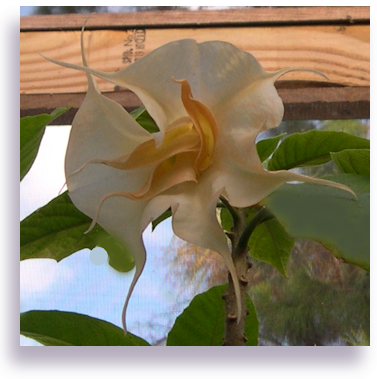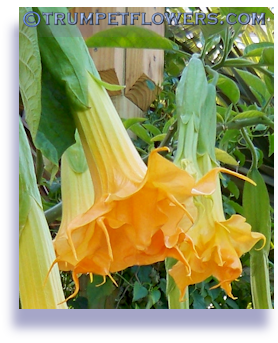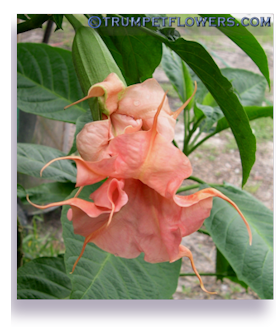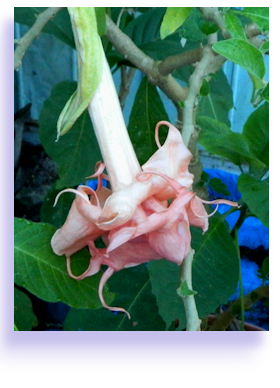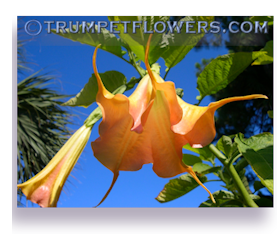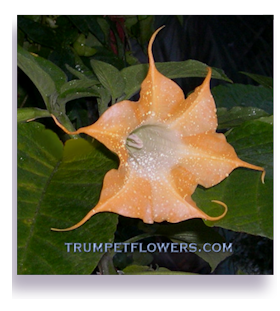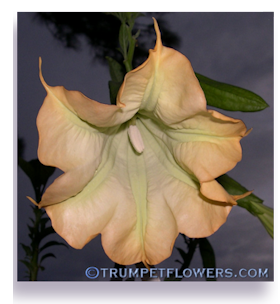Angels Trumpet
Mystique
A little History
Family pronunciation: so-lan-AY-see-eye
Brugmansia, or 'Angel's trumpet' as it is commonly called, is a woody stemmed plant that has long, hanging or pendulous flowers. Brugmansia's relative Datura, is a closely related genera of brugmansia and for many years Brugmansia was included in it. Carl Linne, a very famous botanist, is who first classified datura and brugmansia in this way. I still have relevant books listing brugmansia as datura.There are major differences between the two. Datura is more of an elegant weed, with lovely flowers that point upwards. They do not get a woody stem, and are mostly annuals. Brugmansia, on the other hand, grow into tall, semi∼woody to woody shrubs or trees, and the flowers hang downwards from each node along the branches. Brugmansia can grow to over 20 feet tall in their indigenous regions.
In the year 1805, a South African taxonomist by the name of Christian Hendrick Persoon realized that brugmansia in fact needed it's own genus, and created the two different genera. Unfortunately for the little known or studied brugmansia, it was not until the late date of 1973 that Tom E. Lockwood, now known as a monographer of brugmansia; created the lasting and final division between the two, and it is used up until this day. Sadly, naturalist Lockwood died 2 years later in Mexico in a car accident while driving on a field trip with students.
Grouping Brugmansia Species
Brugmansias are included in the plant family solanaceae, the same family that tomatoes and your garden peppers are in. Brugmansia species are divided into two genetically isolated groups. Warm group Brugmansia includes the species aurea, insignis, sauveolens, and versicolor.
Brugmansia Sphaerocarpium is what is called the Cold Group. It includes the species arborea, sanguinea, and vulcanicola. Until recently, it was very hard for the brug community to find any species of vulcanicola to try and hybridize. They are becoming more available to the community now, and you can find more and more of them in hybridyzing programs. In the states, this group of brugmansia thrive in climates like San Francisco and the Pacific northwest coastline, where it is cool, humid and the temperatures never go below 32°.
There are many fantastic hybridizers growing warm group angel trumpets in these same climates. They just have to offer them more protection, sooner. I even have a hybridizer friend who can only get his out about 4 months a year, living in Michigan. He has some of the most beautiful warm group brugmansia around. He has a basement set up with grow lights to acomodate his plants in winter. He also keeps them thriving enough that they set seed pods for him, so anything is possible in any climate, you just have to have the will to do it.
The Brugmansia cultivars that we enjoy today are mostly hybrids. That is, they will not self-pollinate. Only a few actual species of brugmansia do this on their own. Brugmanisa species Arborea is known to do this. All others, you will have to pollinate yourself.
To identify different Brugmansia cultivars, one has to look at the blooms, and in some cases, the leaves. Brugmansia have several leaf types, those being furry or not, and toothed or not. Otherwise, it's the flowers that give them away. If you cannot identify an Angel Trumpet you've received, then it instantly becomes a NOID, which is sort of an acronymn for NO IDentification. If you really wanted to know what cultivar an untagged brugmansia was, you'd have to have genetic testing done on the plant material in order to really know what cultivar it was. Incidentally, to help in identification, when I can I post the leaf type of each cultivar in the Brugmansia Gallery.
Q and A on ToxicityA fellow hybridizer wrote this up a few years back and said I could share it with you. It deals with questions on toxicity of brugmansia. Thanks for letting me reprint this Jim :)
Q: Are they toxic?
A: Yes, but will harm you only if intentionally eaten in fairly large quantities. I have eaten the leaves myself (not recommended) in small amounts to prove that it will not knock you dead instantly as some people would have you believe. I'm still here!! The leaves taste awful, extremely bitter, nature's way of telling you not to eat it. Most of the reports you hear about serious illness and death relate to brugmansia's close relative the datura or Jimsonweed.
Q: Will they hurt my pets?
A: Probably not, our cats and dogs have grown up around brugmansias for the last 20 yearsand we have yet to have a single problem with them eating the plants or becoming ill from touching them. Summer time the cats are often found sleeping in the shade of the brugmansias. In the winter months the cats hang out in the heated greenhouse amongst hundreds of plants. Our dog's favorite place to bury her bones is usually in a newly tilled bed full of brugmansias and she will dig them up later and chew them with no ill effects. We have lots of wildlife in the yard birds, raccoons, rabbits, squirrels none of which even seem to take notice of the plants never mind eating them.
Note added by me: They will not hurt cats or dogs-I know this firsthand. My cat ate two small plants and is just fine. My dog recently munched on some fallen leaves and it did nothing to him. So I guess it's only toxic to us. My advice would be to keep curious teenagers away from it. Otherwise, it's a fantastically beautiful plant to grow out and admire.
Q: What about young children?
A: My two children have grown up helping in the greenhouse and are always involved in taking cuttings and helping dad pot up the brugmansias. They have never had any problems with handling them and never been tempted to eat them. As with all plants in your yard or house kids need to be taught not to eat them unless given the okay by a grown-up. Remember they taste bad so the chances of a child accidentally ingesting enough to cause harm are slim.
Q: Allergies?
A: As with most plants some people will have slight allergic reactions to the plant fluids that weep from cut areas on the plant, usually a minor rash. If you are sensitive to touching other plants such as tomatoes, potatoes, or any other of the solanaceae family be sure to wash your hands before eating or touching your face.
Other common plants possibly in your yard that are as toxic or more so. Rhododendron, azalea, yew, horse chestnut, fox gloves, delphinium, bleeding heart, snow drops, holly, morning glory, sweet pea, lobelia, lupine, daffodil, potatoes, tulips.
Thanks again Jim, for the use of your writeup.
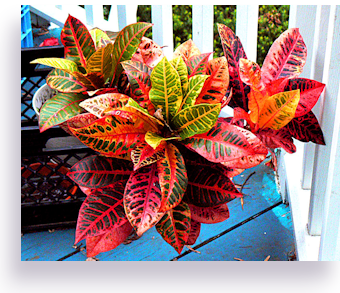 As an example of a widely used landscape plant here in the south, croton is a very poisonous plant, and I've seen literally thousands of them on lawns and used as hedges where I live. So before you show disdain for brugmansia, educate yourself to the other poisionous plants we as humans admire and even cultivate. What about Oleander? Another posionous plant. And don't forget Allamanda, Hollyhock, Castor bean, Morning Glory, Rosary pea, Poinsetta, Mistletoe, English yew, Narcissus, Rhubaran, Dahlia, Adeniums, Pachypodiums, Monkey puzzle tree, Spurge laurel, Snakeroot, Rhododendron, Thevetia, Monkshood, Nightshade...the list goes on and on. Even lima beans are hybridized to contain less cyanide! Do not eat the seed (drupes, or pits) of cherries, peaches or seeds of apples∼they are also toxic. Foxglove is toxic too, but used by the medical community as a heart medication, as are many other 'toxic' plants. Please, before condeming brugmansia to the compost pile, take stock in all the plants we as gardeners grow that have strong potentials for mis-use or abuse of their natural chemical abilites.
As an example of a widely used landscape plant here in the south, croton is a very poisonous plant, and I've seen literally thousands of them on lawns and used as hedges where I live. So before you show disdain for brugmansia, educate yourself to the other poisionous plants we as humans admire and even cultivate. What about Oleander? Another posionous plant. And don't forget Allamanda, Hollyhock, Castor bean, Morning Glory, Rosary pea, Poinsetta, Mistletoe, English yew, Narcissus, Rhubaran, Dahlia, Adeniums, Pachypodiums, Monkey puzzle tree, Spurge laurel, Snakeroot, Rhododendron, Thevetia, Monkshood, Nightshade...the list goes on and on. Even lima beans are hybridized to contain less cyanide! Do not eat the seed (drupes, or pits) of cherries, peaches or seeds of apples∼they are also toxic. Foxglove is toxic too, but used by the medical community as a heart medication, as are many other 'toxic' plants. Please, before condeming brugmansia to the compost pile, take stock in all the plants we as gardeners grow that have strong potentials for mis-use or abuse of their natural chemical abilites.
Indian Tradition and Brugmansia
In South American Indian tradition, parts of the plant historically were made into a drink called 'Tonga'. The drink was administered by the tribe's shaman. Hallucinations, delirium, spasms, shaking, vomiting, loss of vision (or tunnel vision) and sometimes even blindness followed. Today, we know that the plant is toxic, so only an idiot would try to ingest any parts of the plant. Brugmansia often gets a bad rap because some crazed nutjob has decided they should experience the effects, and ends up in the hospital. Almost always, these people will have permanent eye problems afterwards. But there are many other toxic plants that might lie in our gardens, cultivated and loved by us, they are just not as widely discussed as brugmansia. Perhaps this is because they were not used by ancient Indian tribes or widely written about by early American explorers.
For this, brugmanisa have often taken criticism. I have grown them for years, and they are my favorite garden tree. Pooey on the critics I say! This tree is so fantastic; to see one in full bloom, 3 years or older, is stunning! And the fragrance is one that even the neighbors will ask of. Of late, they are becoming popular again, and even received some good press. Here is a link to a great story on them from The Washington PostAngel’s trumpets herald a late summer jungle.
Interesting facts about Brugmansia
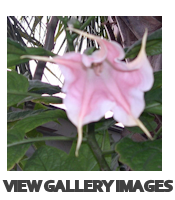 Brugmansia have a very interesting habit in that temperature plays a large role in the color of the blooms. Warm weather can bring paler or deeper colored blooms, depending on the cultivar. A rapid change in temperature can cause blooms to streak in 2 or more colors. I find this fascinating, and it is the first thing that attracted me to the plants many years ago.
Brugmansia have a very interesting habit in that temperature plays a large role in the color of the blooms. Warm weather can bring paler or deeper colored blooms, depending on the cultivar. A rapid change in temperature can cause blooms to streak in 2 or more colors. I find this fascinating, and it is the first thing that attracted me to the plants many years ago.
Brugmansia are very fast growing plants. I have had many cultivars grow over 5 feet in one growing season alone. The growth rate depends largely on care. Knowing that the plant is in the solanacae family, one can properly assume it is a heavy feeder. If you keep your brugmansia properly fertilized, say at least twice a month to even once a week, you will attain the growth rates (and maybe even more) that I listed.
Brugmansia are originally under-canopy trees. This means that deep in the jungles where they originate, they can be found under the boughs of the larger giants of the forest. They do receive light, but most of all they receive protection from high winds in their original niche. Brugmansia cannot tolerate high winds. If a tropical storm is expected, be sure to protect your brugmansia from the strongest of winds.
This is not to say that they are delicate. They are pretty withstanding in my opinion. The branches have lots of give and sway without snapping in most cases. Like a palm tree in the winds, they must have evolved to some degree. Mine regularly withstand 40 mile an hour gusts with no snapping or breaking.
Brugmansia live up to their common namesake in more ways than one. Angel's trumpets is a name given because the blooms are said to point down towards the earth as the trumpet of an angel heralding to we earthlings. But another unique habit (especially with the younger brugmansia) is to see the plant's leaves begin to fold, ever so slightly, inwards with the under leaf surfaces beginning to point up, at dusk. This gives the appearance that the plant is praying.
Breeding New Cultivars
Today, there are several organizations dedicated to the preservation and breeding practices of datura and brugmansia, with stunning results. This plant has surely earned a place in our gardens, with the lovely drooping bells and empyrean fragrance, there will surely be many more new named cultivars to come. Singles, doubles, triples, quadruples and shreddeds in colors of white, pink, peach, pink, almost red, lavendar, and other shades inbetween are seen nowadays. Sadly, many have strived for the elusive 'blue brugmansia', but only those in the cold group are even close, producing lavenderish colored blooms that are beginning to border on blue. Since most people grow the warm group brugs, those would also be a welcome breakthrough.
 My hands∼down favorite organization is Brugmansia Growers International. Wonderful, intelligent and well learned, this group of hybridizers and members is sure to get you on the right track. They offer not only discussion forums, but a wonderful, huge gallery and a database for brugmansia and datura registeries. You can even register your own hybrid baby there someday!
My hands∼down favorite organization is Brugmansia Growers International. Wonderful, intelligent and well learned, this group of hybridizers and members is sure to get you on the right track. They offer not only discussion forums, but a wonderful, huge gallery and a database for brugmansia and datura registeries. You can even register your own hybrid baby there someday!
Tags: angel trumpet history, brugmansia history, brugmansia mystique, brugmansia bloom color changes, aurea, insignis, vulcanicola, datura, brugmansia history, brugmansia organizations,
